The Story of a Steep River: Causes and Effects of the Flash Flood on 24 July 2017 in Western Norway
Abstract
1. Introduction
Flash Flood in the Storelva River (Western Norway) in 2017
2. Materials and Methods
2.1. Hydrologic Modelling and Estimation of Hydraulic Forces for the 2017 Flood
2.2. Visual Documentation and Flooded Area Reconstruction
2.3. Morphodynamic Analysis and Reconstruction of Flow Paths
3. Results
3.1. Final Flooded Area at Qpeak
3.2. Main Flow Paths and New Channel Formation
4. Discussion
4.1. Identification of Critical Points and Uncertainty
4.2. Severity of Flash Floods in Steep Rivers
4.3. Implications and Future Work
5. Conclusions
Author Contributions
Funding
Data Availability Statement
Acknowledgments
Conflicts of Interest
Appendix A
References
- Blöschl, G.; Kiss, A.; Viglione, A.; Barriendos, M.; Böhm, O.; Brázdil, R.; Coeur, D.; Demarée, G.; Llasat, M.C.; Macdonald, N.; et al. Current European flood-rich period exceptional compared with past 500 years. Nature 2020, 583, 560–566. [Google Scholar] [CrossRef] [PubMed]
- Paprotny, D.; Sebastian, A.; Morales-Nápoles, O.; Jonkman, S.N. Trends in flood losses in Europe over the past 150 years. Nat. Commun. 2018, 9, 1985. [Google Scholar] [CrossRef] [PubMed]
- Scorpio, V.; Crema, S.; Marra, F.; Righini, M.; Ciccarese, G.; Borga, M.; Cavalli, M.; Corsini, A.; Marchi, L.; Surian, N.; et al. Basin-scale analysis of the geomorphic effectiveness of flash floods: A study in the northern Apennines (Italy). Sci. Total Environ. 2018, 640–641, 337–351. [Google Scholar] [CrossRef] [PubMed]
- Ruiz-Villanueva, V.; Badoux, A.; Rickenmann, D.; Böckli, M.; Schläfli, S.; Steeb, N.; Stoffel, M.; Rickli, C. Impacts of a large flood along a mountain river basin: The importance of channel widening and estimating the large wood budget in the upper Emme River (Switzerland). Earth Surf. Dyn. 2018, 6, 1115–1137. [Google Scholar] [CrossRef]
- Hooke, J.M. Variations in flood magnitude-effect relations and the implications for flood risk assessment and river management. Geomorphology 2015, 251, 91–107. [Google Scholar] [CrossRef]
- Grove, J.R.; Croke, J.; Thompson, C. Quantifying different riverbank erosion processes during an extreme flood event. Earth Surf. Process. Landforms 2013, 38, 1393–1406. [Google Scholar] [CrossRef]
- Brenna, A.; Surian, N.; Ghinassi, M.; Marchi, L. Sediment–water flows in mountain streams: Recognition and classification based on field evidence. Geomorphology 2020, 371. [Google Scholar] [CrossRef]
- Bruland, O. How extreme can unit discharge become in steep Norwegian catchments? Hydrol. Res. 2020, 51, 290–307. [Google Scholar] [CrossRef]
- Leine, A.-L.Ø. Flomberegning for Storelva i Utvik (087.4Z) (Flood Estimates for Storelva in Utvik (087.4Z); 94/2017; Norwegian Water and Energy Directorate: Oslo, Norway, 2017; p. 20. [Google Scholar]
- Norwegian Water and Energy Directorate (NVE). NEVINA Nedbørfelt-Vannføring-INdeks-Analyse (NEVINA Catchment area-Water Flow-Index-Analysis). Available online: http://nevina.nve.no/ (accessed on 26 March 2019).
- Comiti, F.; Mao, L. Recent Advances in the Dynamics of Steep Channels. In Gravel Bed Rivers: Processes, Tools, Environments; Church, M., Biron, P., Roy, A., Eds.; Wiley-Blackwell: Chichester, UK; Hoboken, NJ, USA, 2012; pp. 353–377. ISBN 978-1-119-95425-5. [Google Scholar]
- Norwegian Mapping Authority (Høydedata). Digital Elevation Model (DEM) Stryn, Resolution 0.5 m. Available online: https://hoydedata.no/LaserInnsyn/ (accessed on 18 November 2018).
- Rønningen, E.S.S. Utløsende Årsaker til Løsmasseskred i Utvik og Stordalen 24 Juli 2017 (Triggering Causes of Landslides in Utvik and Stordalen on 24 July 2017); Norwegian University of Science and Technology: Trondheim, Norway, 2018; p. 78. [Google Scholar]
- Norwegian Water and Energy Directorate (NVE). Norwegian National Landslides Database (Online). Available online: https://temakart.nve.no/tema/SkredHendelser (accessed on 8 February 2021).
- Norwegian Mapping Authority (Kartverket). Orthophotographs Sogn, Pixel Size 0.25 m (Online). Available online: https://norgeibilder.no/ (accessed on 8 February 2021).
- Norwegian Mapping Authority (Kartverket). Orthophotographs Flaum Storelva Utvik, Pixel Size 0.1 m (Online). Available online: https://norgeibilder.no/ (accessed on 8 February 2021).
- Hanssen-Bauer, I.; Førland, E.J.; Haddeland, I.; Hisdal, H.; Lawrence, D.; Mayer, S.; Nesje, A.; Sandven, S.; Sandø, A.B.; Sorteberg, A. Climate in Norway 2100—A Knowledge Base for Climate Adaptation; 1/2017; Norwegian Environmental Agency: Oslo, Norway, 2017; p. 47. [Google Scholar]
- Knighton, A.D. Downstream variation in stream power. Geomorphology 1999, 29, 293–306. [Google Scholar] [CrossRef]
- Moraru, A. Streambank Erosion and Channel Widening: Implications for Flood Hazard; University of Barcelona-Autonomous University of Barcelona: Barcelona, Spain, 2017; p. 25. [Google Scholar]
- Magilligan, F.J. Thresholds and the spatial variability of flood power during extreme floods. Geomorphology 1992, 5, 373–390. [Google Scholar] [CrossRef]
- Ruiz-Villanueva, V.; Bürkli, L.; Mazzorana, B.; Mao, L.; Ravazzolo, D.; Iribarren, P.; Wohl, E.; Nakamura, F.; Stoffel, M. Defining and characterizing wood-laden flows in rivers using home videos. In Proceedings of the 9th International Conference on Fluvial Hydraulics (River Flow 2018), Lyon, France, 5–8 September 2018; Paquier, A., Rivière, N., Eds.; E3S Web of Conferences: Lyon-Villeurbanne, France, 2018; Volume 40, pp. 1–5. [Google Scholar]
- Moraru, A.; Rüther, N.; Bruland, O. Current trends in the optimization of hydraulic flood simulations in ungauged steep rivers. In Proceedings of the 10th International Conference on Fluvial Hydraulics (River Flow 2020), Online, 6–10 July 2020; Uijttewaal, W., Franca, M., Valero, D., Chavarrias, V., Ylla Arbos, C., Schielen, R., Crosato, A., Eds.; Taylor & Francis Group: Delft, The Netherlands, 2020; pp. 1231–1238. [Google Scholar]
- Geological Survey of Norway (NGU). Superficial Deposits-National Database (Online). Available online: http://geo.ngu.no/kart/losmasse_mobil/ (accessed on 16 September 2020).
- Norwegian Mapping Authority (Høydedata). Digital Elevation Model (DEM) NVE Laser Flaum Utvik i Stryn, Resolution 0.25 m. Available online: https://hoydedata.no/LaserInnsyn/ (accessed on 29 March 2019).
- Norwegian Water and Energy Directorate (NVE). Norwegian Hydrologic Database: Built and Non-Built Hydropower Plants. Available online: https://atlas.nve.no/ (accessed on 8 February 2021).
- Norwegian Water and Energy Directorate (NVE). Norwegian National Flood Viewer-Map of 10 to 1000 Years Return Period Flood Events. Available online: https://temakart.nve.no/link/?link=flomsone (accessed on 4 June 2021).
- Bales, J.D.; Wagner, C.R. Sources of uncertainty in flood inundation maps. J. Flood Risk Manag. 2009, 2, 139–147. [Google Scholar] [CrossRef]
- Dam, G. Simulating the Flooding in Utvik on 24 July 2017 Using a High-Resolution 2D Hydro- and Morphological Model.; Dam Engineering: Bergen, Norway, 2018; p. 38. [Google Scholar]
- Smart, G. LiDAR resolution for catchment-inclusive hydrodynamic models. In Proceedings of the 9th International Conference on Fluvial Hydraulics (River Flow 2018), Lyon, France, 5–8 September 2018; Paquier, A., Rivière, N., Eds.; E3S Web of Conferences: Lyon-Villeurbanne, France, 2018; Volume 40, p. 06031. [Google Scholar]
- Choné, G.; Biron, P.M.; Buffin-Bélanger, T. Flood hazard mapping techniques with LiDAR in the absence of river bathymetry data. In Proceedings of the 9th International Conference on Fluvial Hydraulics (River Flow 2018), Lyon, France, 5–8 September 2018; Paquier, A., Rivière, N., Eds.; E3S Web of Conferences: Lyon-Villeurbanne, France, 2018; Volume 40, p. 06005. [Google Scholar]
- Ejigu, D.K. Vannlinjeberegning for Storelva i Utvik i Stryn Kommune (Waterline Calculation for Storelva in Utvik in Stryn Municipality; 8/2020; Norwegian Water and Energy Directorate: Oslo, Norway, 2020. [Google Scholar]
- Norwegian Mapping Authority (Kartverket). Orthophotographs Stryn Mellombels, Pixel Size 0.1 m (Online). Available online: https://norgeibilder.no/ (accessed on 8 February 2021).
- Tonina, D.; McKean, J.A.; Benjankar, R.M.; Wright, C.W.; Goode, J.R.; Chen, Q.; Reeder, W.J.; Carmichael, R.A.; Edmondson, M.R. Mapping river bathymetries: Evaluating topobathymetric LiDAR survey. Earth Surf. Process. Landf. 2019, 44, 507–520. [Google Scholar] [CrossRef]
- Foerst, M.; Rüther, N. Bank retreat and streambank morphology of a meandering river during summer and single flood events in northern Norway. Hydrology 2018, 5, 68. [Google Scholar] [CrossRef]
- Hauet, A.C. Uncertainty of Salt Discharge Measurement: The SUNY Framework; 29/2020; Norwegian Water and Energy Directorate: Oslo, Norway, 2020; p. 23. [Google Scholar]
- Hauet, A.C. SUNY User Manual; 24/2020; Norwegian Water and Energy Directorate: Oslo, Norway, 2020; p. 10. [Google Scholar]
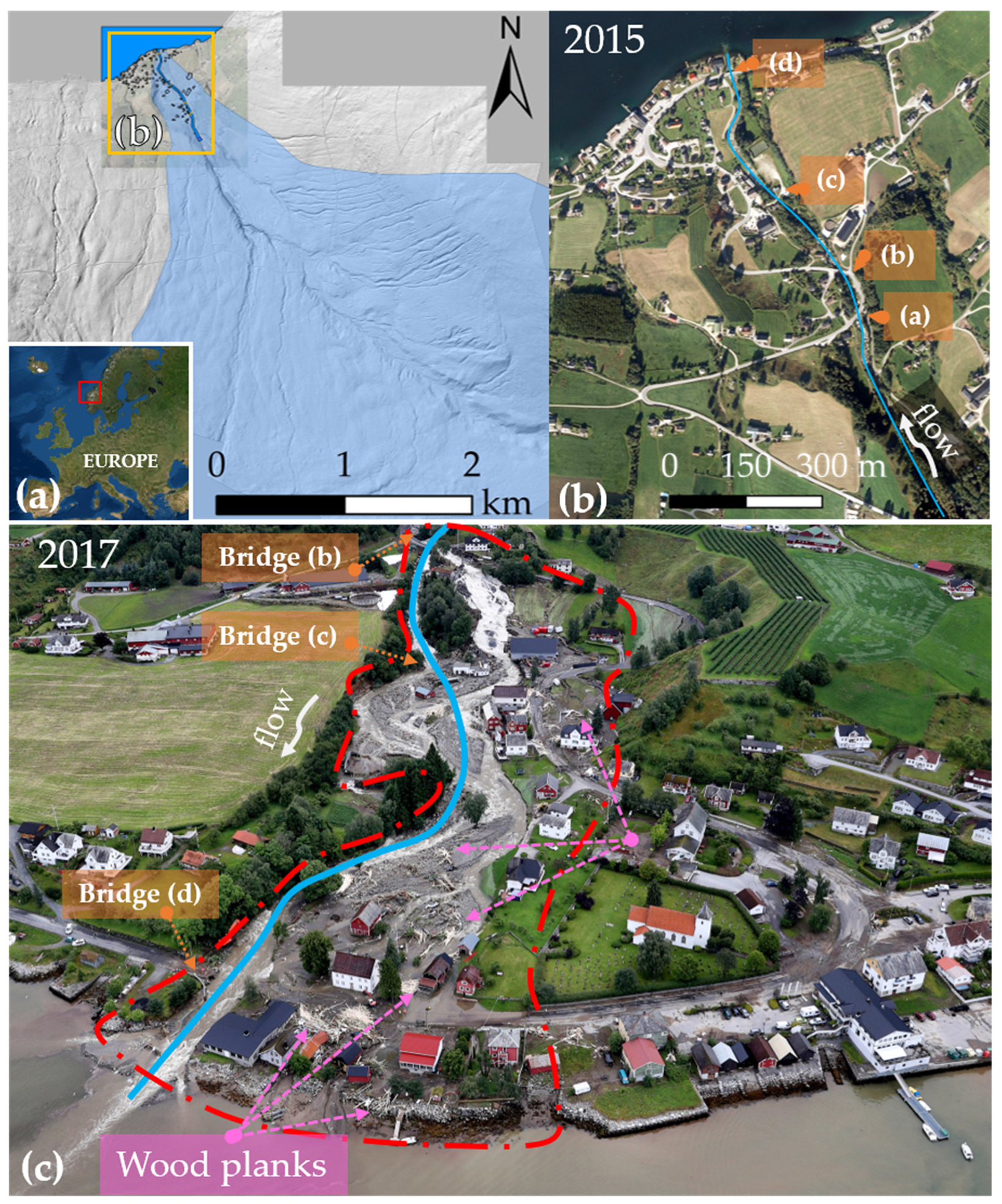
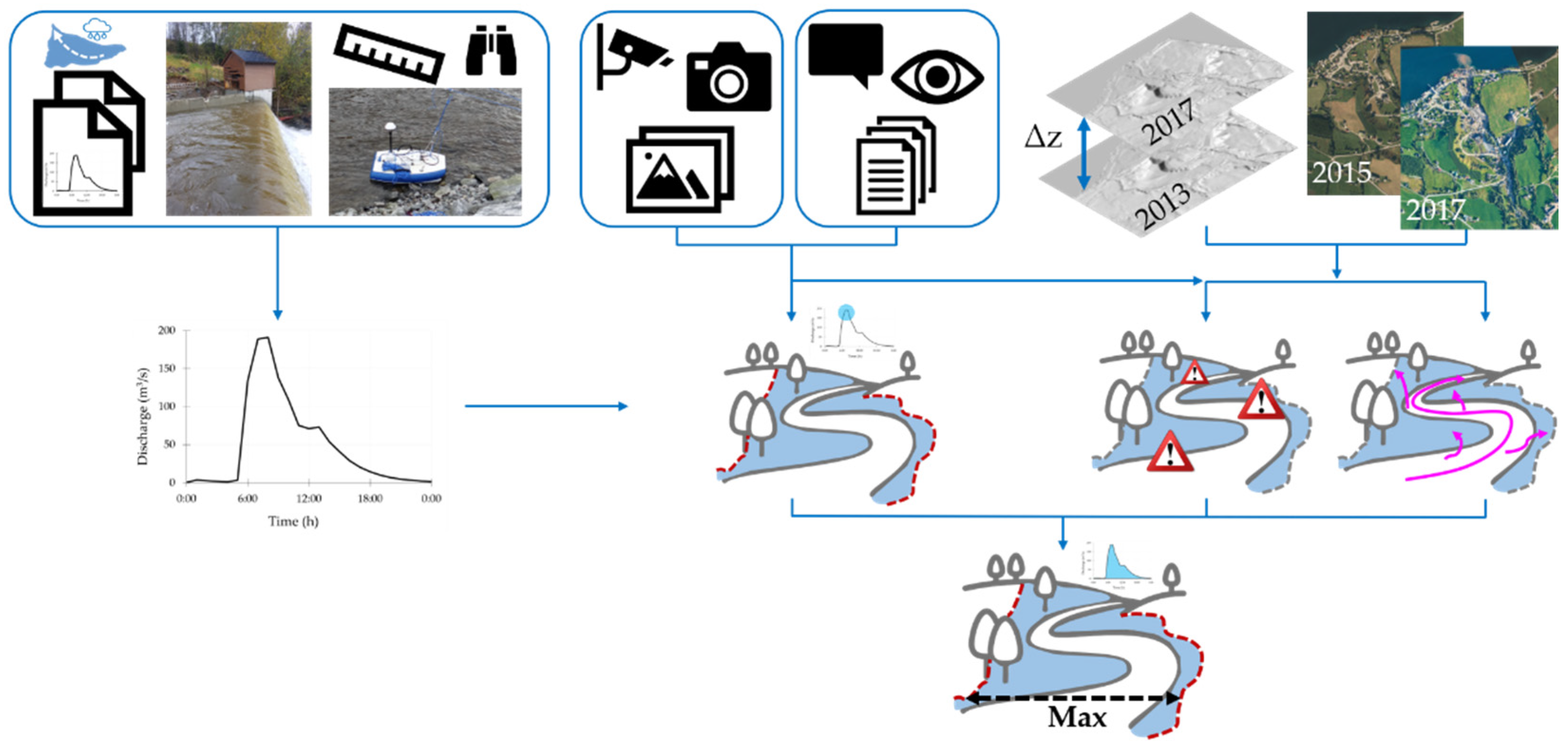
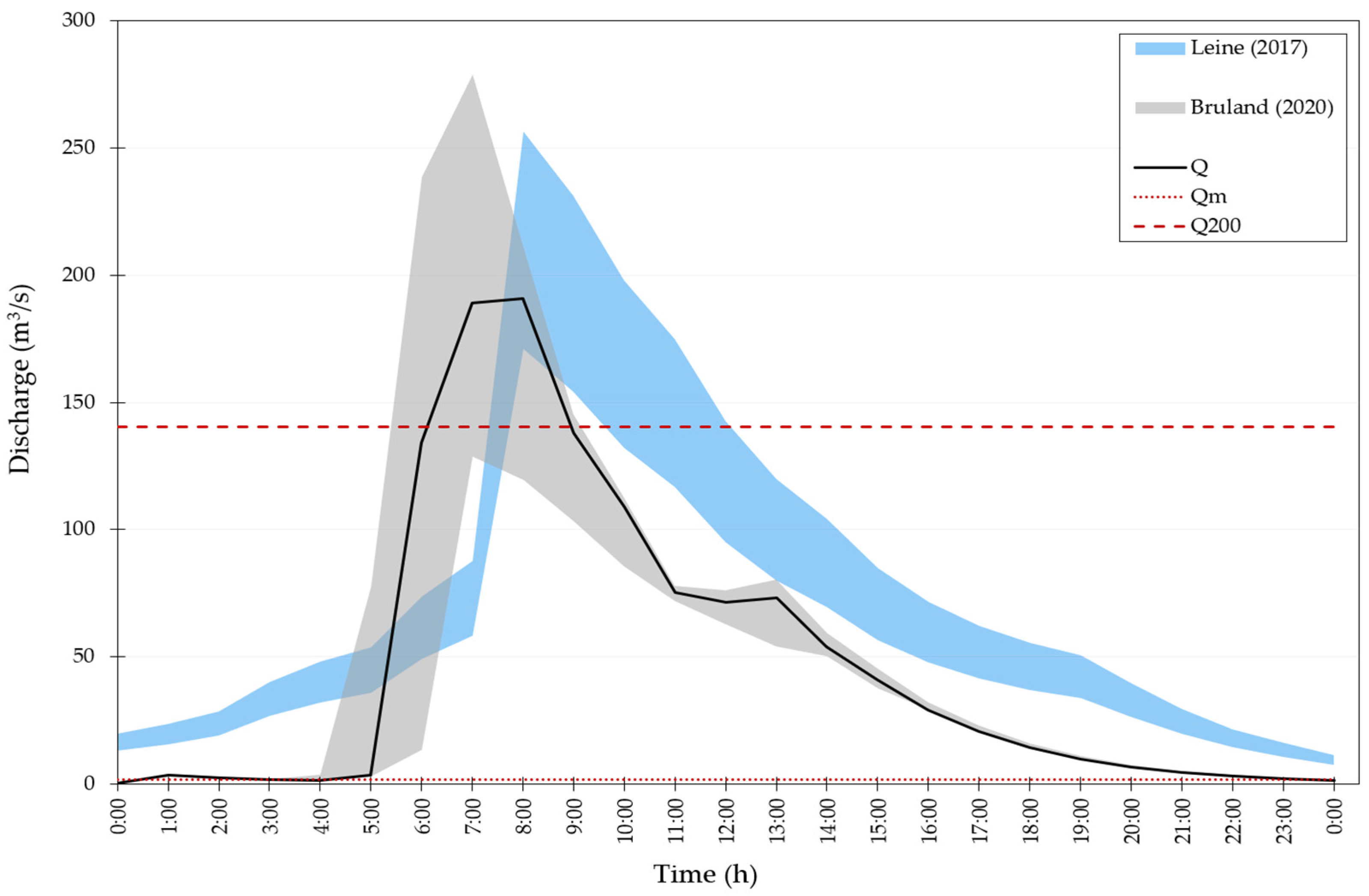
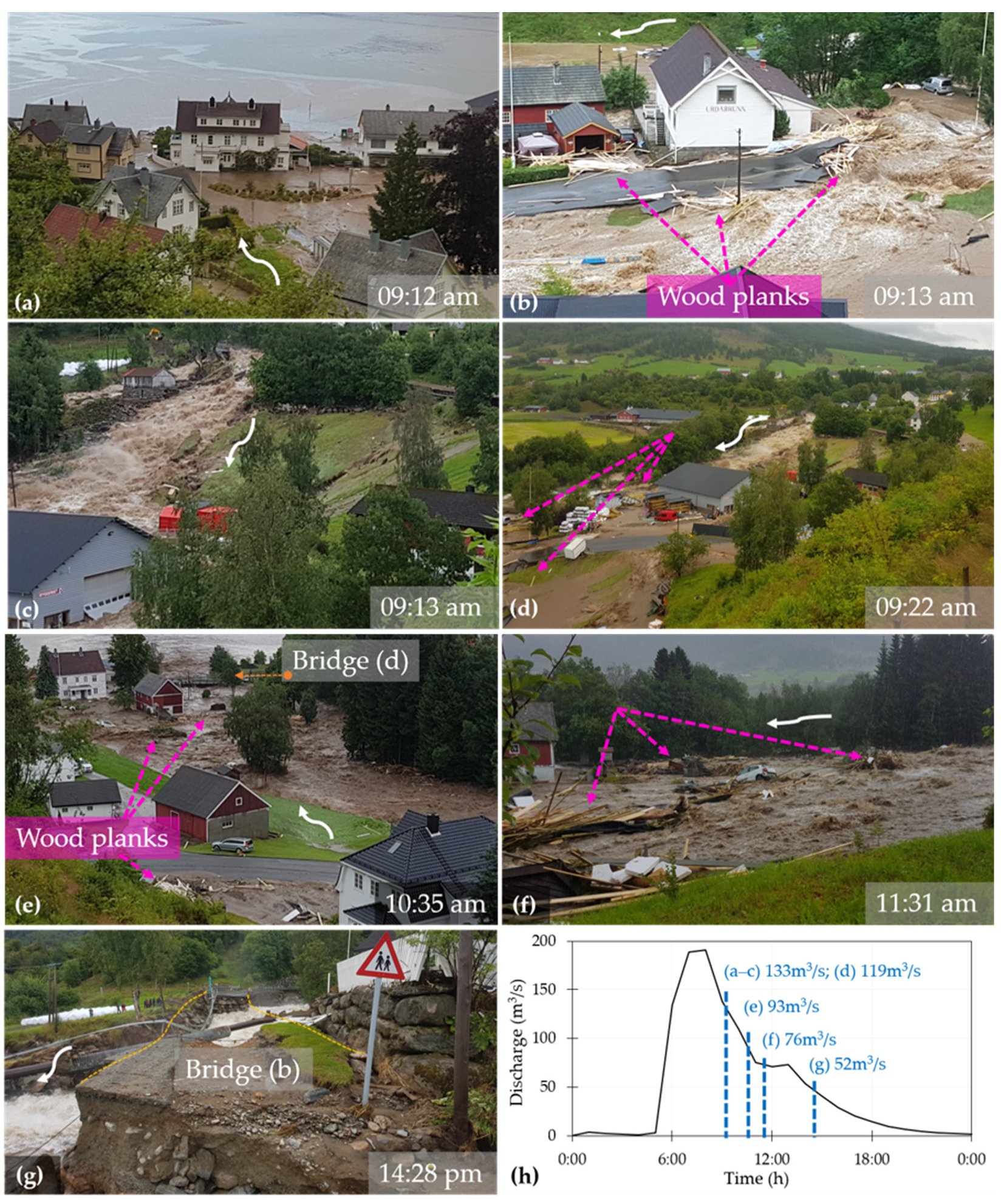
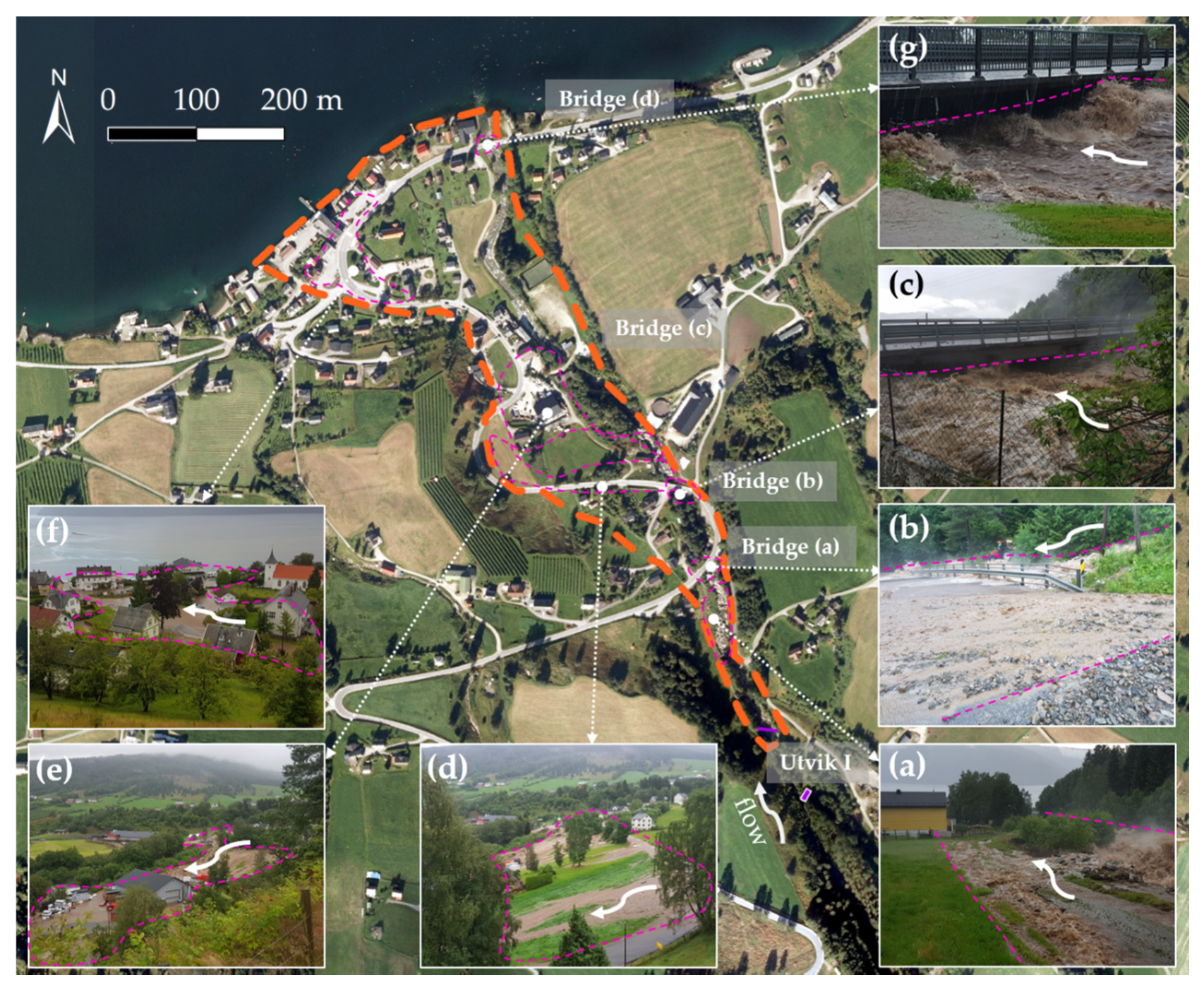
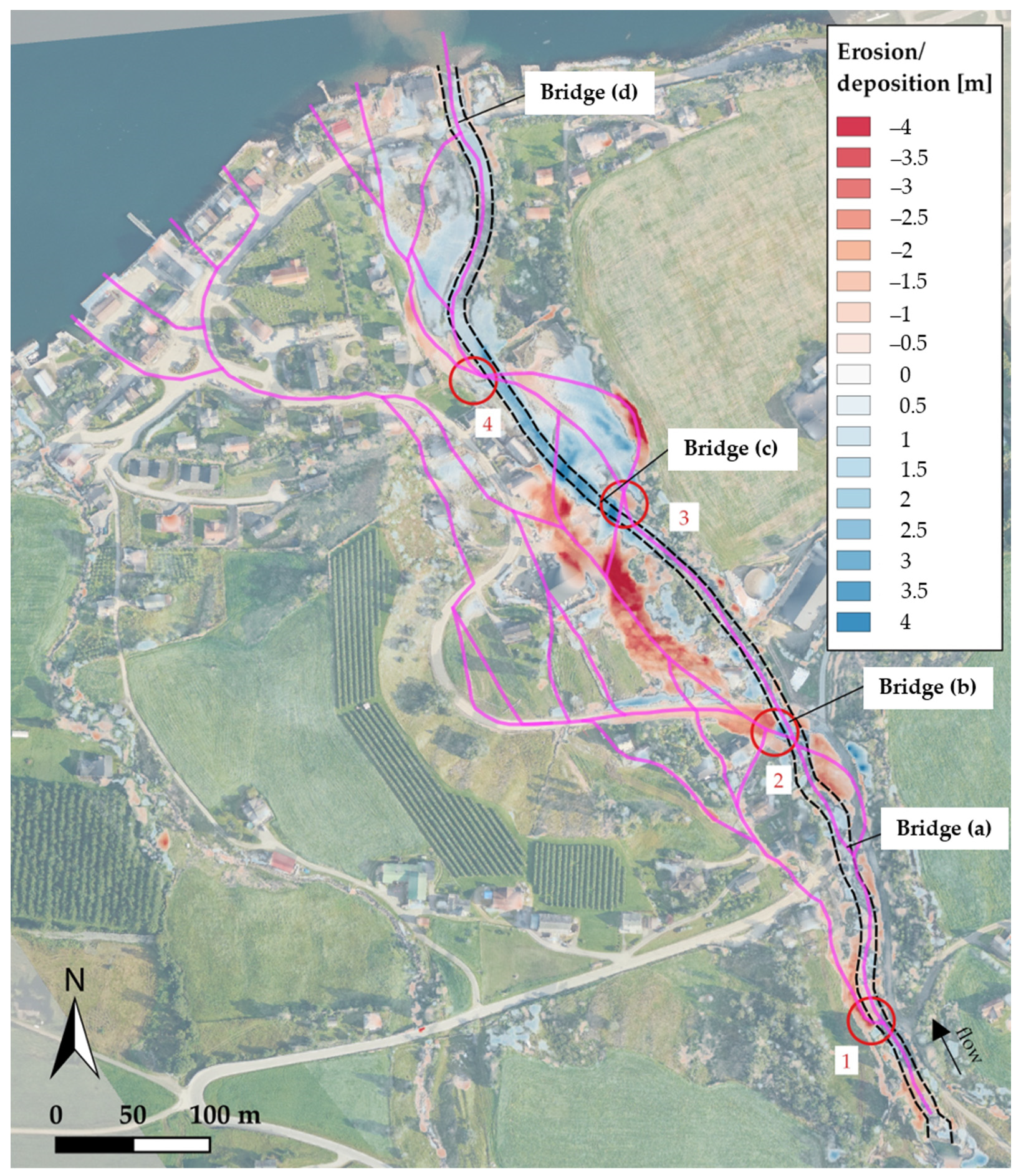
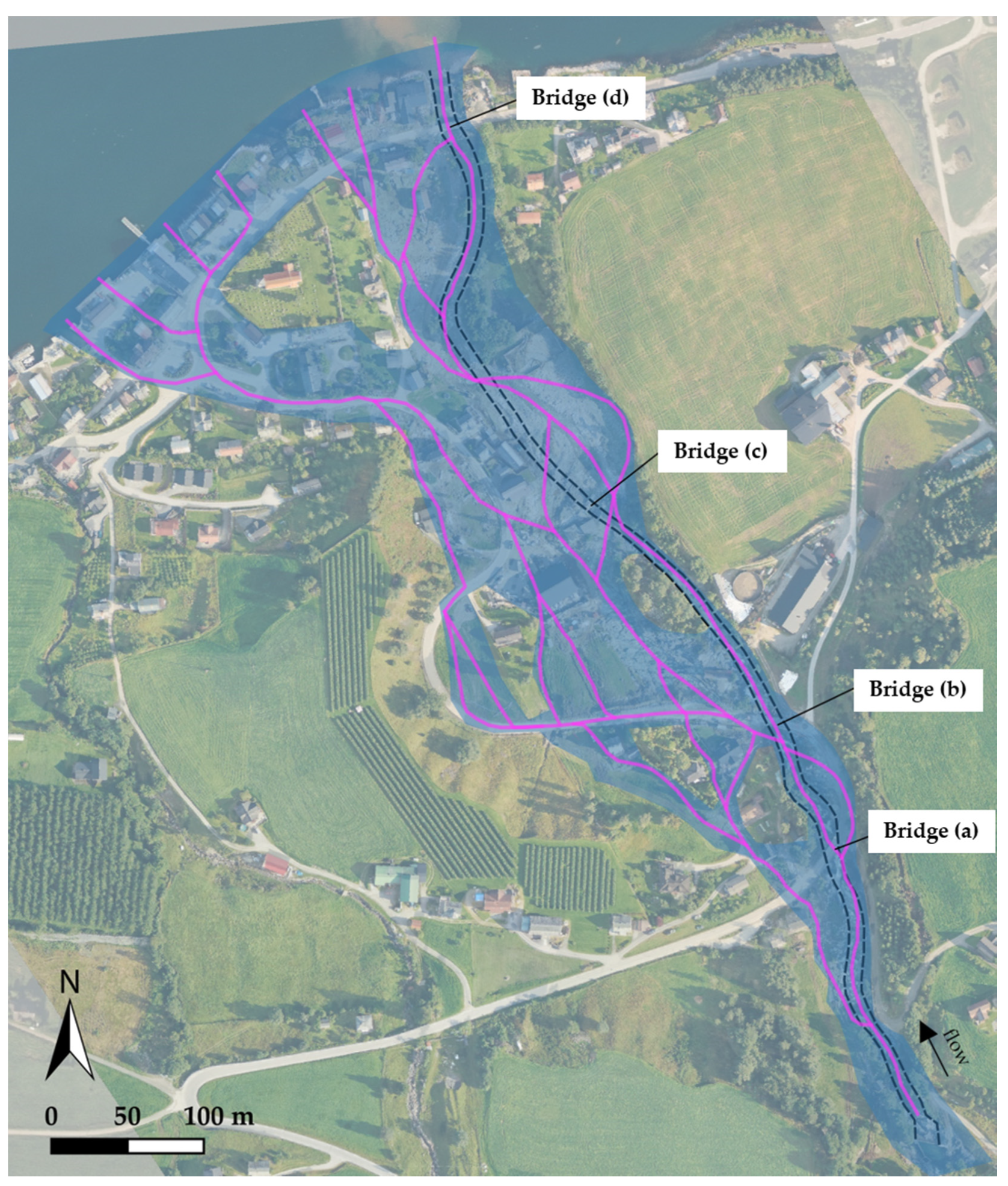
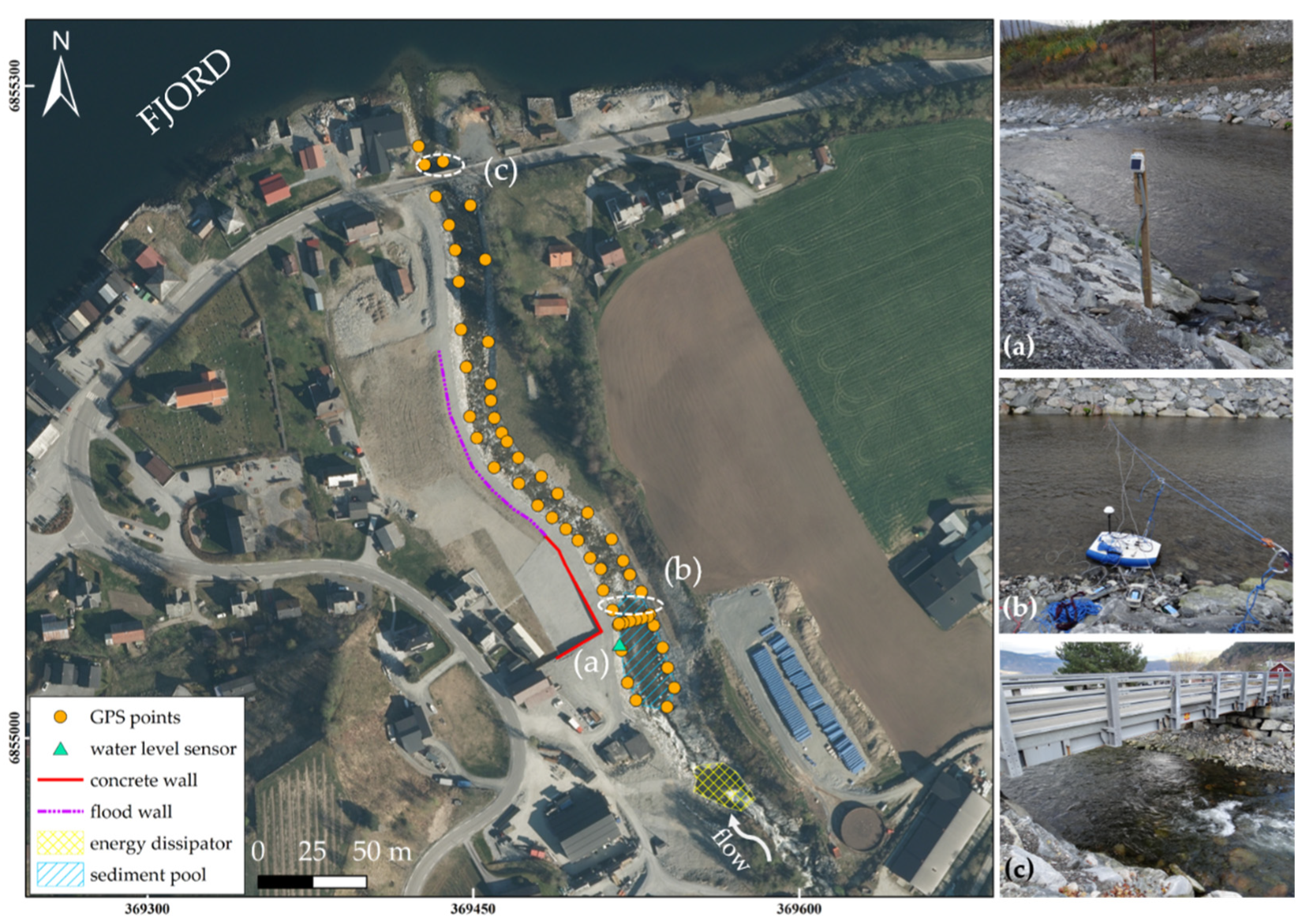
Publisher’s Note: MDPI stays neutral with regard to jurisdictional claims in published maps and institutional affiliations. |
© 2021 by the authors. Licensee MDPI, Basel, Switzerland. This article is an open access article distributed under the terms and conditions of the Creative Commons Attribution (CC BY) license (https://creativecommons.org/licenses/by/4.0/).
Share and Cite
Moraru, A.; Pavlíček, M.; Bruland, O.; Rüther, N. The Story of a Steep River: Causes and Effects of the Flash Flood on 24 July 2017 in Western Norway. Water 2021, 13, 1688. https://doi.org/10.3390/w13121688
Moraru A, Pavlíček M, Bruland O, Rüther N. The Story of a Steep River: Causes and Effects of the Flash Flood on 24 July 2017 in Western Norway. Water. 2021; 13(12):1688. https://doi.org/10.3390/w13121688
Chicago/Turabian StyleMoraru, Adina, Michal Pavlíček, Oddbjørn Bruland, and Nils Rüther. 2021. "The Story of a Steep River: Causes and Effects of the Flash Flood on 24 July 2017 in Western Norway" Water 13, no. 12: 1688. https://doi.org/10.3390/w13121688
APA StyleMoraru, A., Pavlíček, M., Bruland, O., & Rüther, N. (2021). The Story of a Steep River: Causes and Effects of the Flash Flood on 24 July 2017 in Western Norway. Water, 13(12), 1688. https://doi.org/10.3390/w13121688








